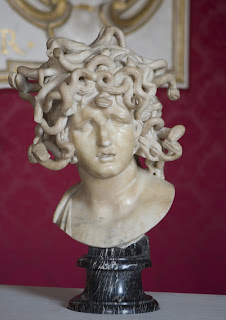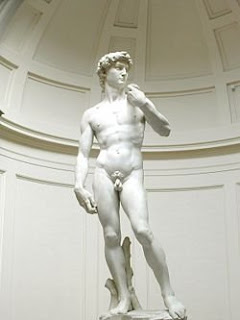
The fact of the matter is this...competition between artists drove the best art in Italy. There are many great stories about how the artwork was vastly improved when there was a competition to earn the commission. The most famous is likely Brunelleschi v. Ghiberti for the Gates of Paradise. Ghiberti went on to win. The result was two of the most beautiful doors in the world. The loss drove Brunelleschi to create the dome of Florence at the mother church.
Michelangelo competed mostly against himself. At times his competition against other artists was real. He very much wanted to create the pendant for his David, but that commission went to a better aligned artist named Bandinelli. He created his Hercules and Cacus; A marvelous work, but would Michelangelo have done better?
The ebb and flow of political alignment surged through Italy’s power base. Who knew the right rich and powerful patrons? What did the Pope want? Who was whispering into the ears of the decision makers to control who earned the work? This is the basis of many decisions. The entire political structure worked from who you knew, being a courtesan, and raising up the identity of your friends. It is very much like today. Is it any wonder that the Ivy league has so many successful alumni? Is it entirely due to their intelligence (which we cannot fully ignore) or is it that the majority of students come from rich and powerful families who are very well connected?
Bernini and Borrimini are two great examples of how the powerbase worked in Rome. As noted in earlier posts Bernini was very well liked and connected. Borrimini wasn’t liked and the decision makers didn’t like working with him due to his difficult nature. Borrimini didn’t do himself any favors being so disagreeable. There were times, however, when Bernini was out of the circle.
Bernini had an embarrassing failure at Saint Peter’s when his bell towers didn’t have the right foundational support and had to be ripped down. This was a lot of egg on his face. Imagine a world without TV or newspapers as we know them today to spread news. Gossip was king and it could ruin people. It drove Bernini into a category of failure he wasn’t use to at all. This lack of divine light on Bernini opened the door for Borromini to win some important commissions. The powers that be are fickle and if you don’t stroke the right people bad things happen.
Pope Innocent X wanted to decorate Piazza Navona. His family home was on the Piazza along with his family church. Borromini was a respected (although disliked) architect/engineer. The pope asked him to pipe water into the Piazza using some of Ancient Rome’s springs and aqueducts. He successfully did so for the Pope. Then Pope Innocent X wanted a fountain to raise the caliber of the Piazza to Papal standards and change it from a market to a socially graceful Piazza worthy of a Pope. Borromini dreamed up the design of the fountain being built with the four major rivers of the world and went so far as to draw sketches to illustrate his vision.
Bernini was still out of favor, but his allies worked with him to bypass his ill-favor and help him win the commission anyway. At a dinner party with the Pope the model built by Bernini was placed so that the Pope would see it as he walked from room to room. See it the Pope did and fell in love with the design. This was a risk taken by Bernini’s ally and Bernini himself. The commission was given to him. Think of poor Borromini. He built the pipes to bring the water to Piazza Navona, came up with the design, and still lost the commission. Why? Bernini had people working with him behind the scenes and put him in a position to win at every turn.
You always attract more bees with honey. (That would have been a great metaphor if the Pope came from the Barberini family :)). The point of this is simple, the art of Italy is even more beautiful if you understand what happens behind the curtain and that it is always better to be graceful and fully understand who is making the final decision where commissions are concerned.
Michelangelo competed mostly against himself. At times his competition against other artists was real. He very much wanted to create the pendant for his David, but that commission went to a better aligned artist named Bandinelli. He created his Hercules and Cacus; A marvelous work, but would Michelangelo have done better?
The ebb and flow of political alignment surged through Italy’s power base. Who knew the right rich and powerful patrons? What did the Pope want? Who was whispering into the ears of the decision makers to control who earned the work? This is the basis of many decisions. The entire political structure worked from who you knew, being a courtesan, and raising up the identity of your friends. It is very much like today. Is it any wonder that the Ivy league has so many successful alumni? Is it entirely due to their intelligence (which we cannot fully ignore) or is it that the majority of students come from rich and powerful families who are very well connected?
Bernini and Borrimini are two great examples of how the powerbase worked in Rome. As noted in earlier posts Bernini was very well liked and connected. Borrimini wasn’t liked and the decision makers didn’t like working with him due to his difficult nature. Borrimini didn’t do himself any favors being so disagreeable. There were times, however, when Bernini was out of the circle.
Bernini had an embarrassing failure at Saint Peter’s when his bell towers didn’t have the right foundational support and had to be ripped down. This was a lot of egg on his face. Imagine a world without TV or newspapers as we know them today to spread news. Gossip was king and it could ruin people. It drove Bernini into a category of failure he wasn’t use to at all. This lack of divine light on Bernini opened the door for Borromini to win some important commissions. The powers that be are fickle and if you don’t stroke the right people bad things happen.
Pope Innocent X wanted to decorate Piazza Navona. His family home was on the Piazza along with his family church. Borromini was a respected (although disliked) architect/engineer. The pope asked him to pipe water into the Piazza using some of Ancient Rome’s springs and aqueducts. He successfully did so for the Pope. Then Pope Innocent X wanted a fountain to raise the caliber of the Piazza to Papal standards and change it from a market to a socially graceful Piazza worthy of a Pope. Borromini dreamed up the design of the fountain being built with the four major rivers of the world and went so far as to draw sketches to illustrate his vision.
Bernini was still out of favor, but his allies worked with him to bypass his ill-favor and help him win the commission anyway. At a dinner party with the Pope the model built by Bernini was placed so that the Pope would see it as he walked from room to room. See it the Pope did and fell in love with the design. This was a risk taken by Bernini’s ally and Bernini himself. The commission was given to him. Think of poor Borromini. He built the pipes to bring the water to Piazza Navona, came up with the design, and still lost the commission. Why? Bernini had people working with him behind the scenes and put him in a position to win at every turn.
You always attract more bees with honey. (That would have been a great metaphor if the Pope came from the Barberini family :)). The point of this is simple, the art of Italy is even more beautiful if you understand what happens behind the curtain and that it is always better to be graceful and fully understand who is making the final decision where commissions are concerned.






















































